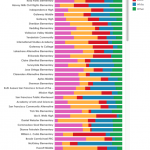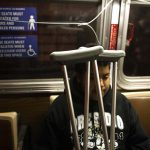By 2005, when a federal judge lifted the most recent desegregation orders, San Francisco Unified School District had been trying for more than three decades to make its schools more racially and socioeconomically diverse, starting in 1971 with forced busing.
San Francisco schools no longer exhibit the level of racial isolation they once did, but they are now resegregating, as are many others across the country. In 2013–2014, in more than one-quarter of city schools, 60 percent of the students were of one race. That is a far cry from 1966, when more than one-third of the schools had student populations with 80 percent or more belonging to a single racial group. (In 2014, just three schools were segregated to that degree.)
The district has long had large black, white, Asian and Latino populations, with the latter two accounting for rising shares as the school system shrinks.
Factors contributing to resegregation include court rulings and laws barring educators from considering race in admissions and school assignment. But an evolving school choice program that is harder for lower-income families to navigate and limited availability of free transportation also play a role.
More than six decades have passed since the U.S. Supreme Court banned government-sponsored segregation in its ruling in Brown v. Board of Education, and it has been five decades since the federal Civil Rights Act of 1964 prohibited discrimination based on race, color or national origin in programs that receive federal aid.
Here is how desegregation efforts and demographic shifts have unfolded in San Francisco.
UNTIL 1971:
Neighborhood schools: Through the civil rights era, many San Francisco schools are dominated by a single ethnic or racial group, and white students are the largest, at 40 percent in 1969.
1969: First lawsuit over school segregation in San Francisco is filed, Johnson v. San Francisco Unified.
1971–1978
Imposition of busing: In response to a court order in the Johnson case, the district institutes forced busing, which helps make schools more diverse but is soon challenged and abandoned. As white families flee San Francisco’s public schools, black students become the largest racial group in 1973, accounting for 30 percent.
1971: In response, Chinese-American families unsuccessfully sue for an exemption in Guey Heung Lee v. Johnson.
1971: More than 48,000 San Francisco students are assigned to new schools under the district’s compulsory “horseshoe plan,” named after the shape of bus routes on a map. During the first few weeks, 40 percent of students skip school as parents boycott forced reassignments.
1973: Federal courts issue rulings leading to desegregation orders in Denver, and then in Boston and Detroit the following year. Forced busing spreads nationwide and violent parent protests erupt.
1974: San Francisco Unified is ordered to establish a Chinese bilingual program to end a lawsuit (Lau v. Nichols) claiming that 2,500 immigrant students are not getting a meaningful education.
1978–1983
Legal shifts: The backlash against forced integration comes from many quarters, chiefly parents and the courts. Parents are unhappy with their children’s long commutes and lack of access to language programs. By 1979, Asians are the largest racial group among San Francisco students, at 29 percent.
1978: Federal judge Stanley A. Weigel finds large-scale forced busing is no longer necessary in San Francisco and orders it to end.
1978: The NAACP files a lawsuit seeking resumption of school assignments that emphasize racial diversity.
1978: A splintered U.S. Supreme Court rules in Bakke v. University of California that affirmative action is acceptable in some forms but that U.C. Davis’ criteria for medical school admissions went too far.
1979: California voters approve Proposition 1 outlawing forced busing.
1983–1999
Racial quotas: The NAACP and San Francisco Unified reach a settlement intended to encourage racial balance in city schools. But the resulting quota system is heavily criticized.
1983: A consent decree sets a quota of 45 percent for the maximum share of each San Francisco school’s population that can be of any single race. It mandates that at least four racial groups (out of nine represented in the district) be represented in each school. San Francisco gets $30 million a year in extra state funding to comply with the court order.
1983: The district automatically assigns students entering the fifth and eighth grades to their neighborhood schools but they can choose another enrollment process designed to spur diversity by making randomized assignments. As described later by a school official in court papers, if any given student’s race already accounts for 45 percent or more of the population of his or her preferred school, the student is sent to another school.
1994: A Chinese-American student claims in a lawsuit, Ho v. SFUSD, to have been denied admission to the prestigious, public Lowell High School based on his race.
1995: The U.S. Supreme Court rules in Missouri v. Jenkins that court remedies to segregation should be “limited in time and extent.”
1995–1996: The UC Regents drop race, sex, religion, gender and national origin as admissions criteria. California voters pass Proposition 209, banning traditional affirmative action in all public education, employment and contracting.
1999–2005
New strains on diversity: In settling Ho v. SFUSD, the district agrees to a consent decree barring the use of race in school assignments.
2001: The district implements a court-approved policy called “Excellence for All,” which promises equitable allocation of resources, a drive to improve all students’ achievement and accountability.
2001: The new “diversity index” lottery for student assignment intends to do three things:
- Give families choice
- Ensure equitable access to programs
- Promote diversity without using race or ethnicity admissions criteria
2004: Educator Henry Der writes in the Asian American Law Journal that changing student demographics, the removal of race and ethnicity from the school assignment process, and “parental avoidance of low-performing schools” have contributed to rising resegregation in San Francisco. He finds “every indication that San Francisco public schools will become even more racially identifiable as the African-American and white student populations decline.”
2005–Present
Parental choice: The district embraces the ideal of diversity but has few tools to achieve it. In a report on student assignment policies, district leaders say “the trend of racial isolation and concentration of underserved students” cannot be reversed through student assignment alone. Sidestepping disparities in funding, access and programs, the report concludes that to promote diversity the school board would need to send students to schools they never chose, far from where they live.
2004-2005: Forty-three San Francisco schools are overwhelmingly segregated, with 27 of them entirely segregated.
2005: A federal judge rejects San Francisco Unified’s request to extend the consent decree in the Ho case, and it expires. That ends court involvement in school assignment.
2007: The U.S. Supreme Court finds voluntary integration efforts in Seattle unconstitutional. But five of the nine justices write that there remains a “compelling interest in avoiding segregation.”
2011: San Francisco Unified adopts a new school assignment system, abandoning the diversity index and giving parent choice top priority. It begins a three-year plan for significant cuts in its budget for busing students.
2014: Administrators say funding, community opposition to busing and parent preference for neighborhood schools limit the ability of school assignment policies to overcome segregation.
This story was published in the winter 2015 print edition of the Public Press. For the full report rolling out online through early February, see sfpublicpress.org/schooldiversity. To read the 2014 report on the effects of parent fundraising and (follow-up coverage), see sfpublicpress.org/publicschools.









